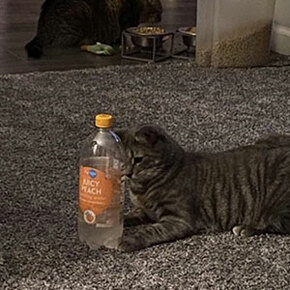
20 Of The Best Underwater Photos From Ocean Art Contest 2023
The mesmerizing beauty of the underwater world has always captivated the imagination of both professional and amateur photographers. The Ocean Art Contest 2023 showcased the incredible talents of photographers who dared to explore the mysterious depths of the ocean, capturing stunning moments that few get to witness. From vibrant coral reefs to elusive marine creatures, the contest unveiled a treasure trove of underwater wonders.
Let’s dive into the depths and explore some of the best underwater photos that left a lasting impression on the judges and viewers alike.
#1 Best In Show And 1st Place In Portrait: “Aquatic Primate” By Suliman Alatiqi

Image source: Underwater Photography Guide
Phi Phi Islands, Thailand “During fieldwork at Phi Phi Islands, Thailand, spanning several weeks, I focused my efforts on documenting the maritime behavior of the Crab-eating macaque with particular focus on their water forages. The macaques have adapted very well to living around the sea and will venture into the water for various reasons including transportation, scavenging, cooling down and playing. Highly efficient swimmers, they can dive for up to half a minute and can cover short distances faster than most humans. This photo offers a rare glimpse of the swimming movement of a male macaque.”
#2 2nd Place In Macro Category: “Pygmy Poser” By Byron Conroy

Image source: Underwater Photography Guide
Lembeh Strait, Indonesia “I have photographed pygmy sea horses for many years, there are a few challenges to shooting them, first the eye contact. To have a relaxed specimen making double eye contact with the camera is very rare, secondly the polyps of the coral are usually closed. In order to get the polyps out I had to be the first person on this sea fan in the morning, I already knew this was a playful specimen from the day before so requested to dive the site at dawn when the polyps were out. And this guy is also pregnant and about to burst, so this trifecta of eye contact, polyps out and pregnant male made it the shot I have been after for many years. There was minimal editing, a little contrast, a slight rotation and very minimal crop were all that was needed, the subject speaks for itself.”
#3 Honorable Mention In Portrait: “Belle” By Celia Kujala

Image source: Underwater Photography Guide
Norris Rocks, Hornby Island, Canada “As I immersed myself in the underwater world at Norris Rocks, I took my time to observe and try to understand the Steller sea lions aiming to capture more meaningful images. This image was captured when a beautiful sea lion swam up to me and stared tenderly into my eyes melting my heart. Steller sea lions are listed as Near Threatened on the IUCN Red List. With this image I hope to ignite a desire within people to protect these extraordinary beings and their ocean home.”
#4 4th Place In Portrait: “Everything Is A-Ok” By Gabriel Jensen

Image source: Underwater Photography Guide
Lauderdale-by-the-Sea Pier, Florida, USA “Summer brings calm seas to South Florida where a dedicated community of shore divers heads out nearly every day to survey for cool critters. I was signaled over by my friends, Dewalt and Evelyn who had spotted this lizardfish grappling with a challenge, its eyes perhaps larger than its mouth. The comically calm doctorfish steals the spotlight, displaying a remarkable defense mechanism with splayed pectoral and dorsal spines. Typically, in these images, the lizardfish is the star of the show, but in this case, I rotated the image to emphasize the doctorfish’s stoic demeanor, reminiscent of the ‘everything is fine’ meme.”
#5 1st Place In Wide-Angle Category: “Bunk Buddies” By Suliman Alatiqi

Image source: Underwater Photography Guide
Roca Partida, Mexico “Whitetip reef sharks are one of few shark species that rest in place. At Roca Partida, a small island, real estate is limited for the many whitetips that live there and they can often be seen bunking together. I wanted to get a photo of all of them facing me and with a lot of patience and a careful approach I managed to do so.”
#6 2nd Place In Marine Life Behavior: “Mother’s Day” By Josh Raia

Image source: Underwater Photography Guide
Crystal River, Florida, USA “During the chilly winter months in northern Florida, West Indian manatees congregate in the crystal-clear natural spring waters to keep warm. Temperatures in the surrounding rivers can drop dangerously low so the aquifers act as safe havens where they can rest and raise their young. Manatee mums nurse their calves from just beneath their armpits until they are strong enough to strike out on their own. Over the years I have witnessed what wonderful parents they are, tending to every beck and call of the little ones. This tater tot must have been hungry because it spent most of the day attached to mom! I have also heard that calves hang on to hitch a ride if they are tired of swimming for the time being. The juvenile manatees are very curious, often coming right up to you as long as you are calm and find a respectable distance to patiently observe. The mother will typically swim over and scoop them up if they are getting too close to divers in the water. The springs must be a whole new world for them out there to explore, and I am so thankful for the encounter this year.”
#7 3rd Place In Portrait: “Fresh Start” By Jules Casey

Image source: Underwater Photography Guide
Mornington Peninsula in Victoria, Australia “Every year thousands of Giant Spider Crabs come into Port Phillip Bay for their annual molt. They gather in large numbers and shed their old exoskeletons. Once molted they double in size while their new shell hardens over the next couple of days. During this time, they are vulnerable to predators, so they gather tightly in large numbers to reduce the risk of being eaten. This freshly molted Giant Spider Crab stands in front of a group of crabs yet to molt, allowing me the opportunity to take a portrait shot.”
#8 2nd Place In Coldwater: “Pup Playtime” By Celia Kujala

Image source: Underwater Photography Guide
Lobster Shack, Coronado Islands, Mexico “California sea lions are born in early summer in the Coronado Islands. Play is very important in their development. By late fall they have grown to be very confident in the water and can often be seen play fighting each other. I watched these two pups swirl around together and playfully bite each other. For now, it is all for fun as they learn skills that will help them later in life.”
#9 Honorable Mention In Marine Life Behavior: “Giving Birth” By Todd Aki

Image source: Underwater Photography Guide
East Coast of Central Sulawesi, Indonesia “I let my wife choose our last dive of the trip, either an unguided shore dive or a boat dive. Although she loves wide angle sites from the boat, she picked the shore dive. It was because the house reef was on fire! Mimics and wonderpus were so common we stopped pointing them out. There was an explosion of ghost pipefish of varies types. So many different types of frogfish. I saw so many hairy frogfish, I stopped taking pictures of them. I was diving the house reef before sunrise and at night without my wife and she surprisingly, had not seen a hairy the entire trip. This last dive was a quest for us to find her a hairy. The dive did not disappoint. We saw so many different types of cephalopods including a, yawn, mimic. We came across a newly laid patch of squid eggs which strangely, had a seahorse attached. While shooting this unusual combination, a school of razorfish photobombed the picture. We were at the end of the dive when I spotted something that did not make sense. Why was a seahorse in the water column? I could not believe my eyes at what happened next. The seahorse convulsed and out came hundreds of babies. Shooting is always my top priority but I wanted my wife to experience this moment with me so I banged my tank with my muck stick to get her attention and missed the opportunity to fire off a couple of shots. I was able to get into position and got three shots at the male seahorse’s next release. My wife was now at my side and the current took the baby seahorses right next to her mask. There was one more release with just few more babies than the seahorse dropped to the ocean floor exhausted. I was so happy my wife was able to experience this once in a lifetime encounter with me. But we never found her a hairy frogfish.”
#10 2nd Place In Nudibranchs: “Cutie Guardian” By Yen-Po Huang

Image source: Underwater Photography Guide
Tulamben, Indonesia “Costasiella kuroshimae is one of the famous nudibranchs in Tulamben. It has a tiny cute face and beautiful eggs in a perfect circle. I spent two dives waiting for it to creep up to its eggs. It looked like it was defending eggs. If it was, it must be the cutest guardian of all nudibranchs.”
#11 Honorable Mention In Wide-Angle Category: “Rainbow” By Ipah Uid Lynn

Image source: Underwater Photography Guide
Male, Maldives “I haven’t seen whale sharks for the longest time. Maldives are known for encountering Whale Sharks. I was very lucky on the first day as I manage to see a few. This one particular whale shark was very friendly. It kept circling around me as I had all the small fishes attracted to my focus lights. I guess for him it was a free buffet as the planktons were a lot that night as well. I stayed there for about an hour until dawn as I wanted the golden light to reflect on the small fishes and it paid off!”
#12 2nd Place In Portrait: “Octopus Macropus, Polpessa” By Alessandro Raho

Image source: Underwater Photography Guide
Noli, Ligurian Sea, Italy “This photo was taken in June 2023 at the dive site: “Sabbione delle Meraviglie” in front of Noli in the Ligurian Sea. I immediately identified this cephalopod by its characteristic spotted coat. I have met these animals other times, but they usually tend to run away, however the defense behavior of this subject was different, in fact the animal opened its tentacles to appear more threatening by rising from the seabed with 2 tentacles and widening the other 6.”
#13 3rd Place In Blackwater: “Snowy Night” By Jialing Cai

Image source: Underwater Photography Guide
Anilao, Batangas, Philippines “I captured this image during a blackwater dive a few days after the Taal Volcano eruption in the Philippines in early 2020. This female paper nautilus was hitchhiking on a floating piece of wood debris in the extremely turbid water. It belongs to the octopus genus called Argonauta, one of the few octopi’s lineages that live in the open ocean. The females are unique in having evolved a shell for laying eggs. As I pressed the shutter, the surrounding particles reflected my flashlight in a manner that created the illusion of falling snow. For blackwater photography, we like to place the strobes in an angle and position where the light can shine directly on the subject, ensuring a clean dark background. However, when I initially attempted to capture this Argonaut, I was unaware that the strobes were placed in a “wrong” position. The light was shining on the space between the subject and my camera, which had illuminated the presence of all the surrounding particles. Instead of portraying chaos in the aftermath a natural disaster, these particles evoked an unusual sense of serenity, transforming the scene into a fairytale set on a snowy night. Blackwater photographers are obsessed with clear water. We are drawn to the pure darkness that mirrors the vacuum of outer space. We tend to forget that the suspended particles which include the sand grains, organic matter and even miniscule organisms are an integral part of the ecosystem. These particles always fade into the background or are simply removed through editing, but they form the foundation of the complex marine food web. If the water were genuinely transparent, there’s no way the ocean could sustain such abundance of life. The “snowflakes” in this captured scene always remind me of these tiny yet ubiquitous existences.”
#14 1st Place In Compact Macro: “Underwater Fireworks” By Imogen Manins

Image source: Underwater Photography Guide
Mornington Peninsula, Australia “In the shallow waters of Naarm (Port Phillip Bay), sparse colonies of Tubular Hydroids poke their heads out of the sand in cold, shallow water. There are hundreds of individuals, but at just 4cm or so tall it’s easy to dismiss these tiny animals which are endemic to the Great Southern Reef of Australia. Each individual here is either male or female and extend their outer tentacles to catch passing plankton. Blairgowrie Pier is a sheltered site, well known to local divers for the spectacular colours of sessile and invertebrate creatures. After 90 minutes in 12°C water, my fingers were becoming numb. Usually, I exit the site at the dive platform, but this time I began a shore exit, noticing tiny hydroids on the sandy bottom. After inspecting several groups, I chanced on this beautifully arranged colony of ‘Underwater Fireworks’. Trying not to disturb the sand was challenging in this environment. I watched the tentacles move delicately in the water, making small adjustments until I was happy with the composition.”
#15 2nd Place In Compact Macro: “Radioactive” By Marcus Commodore

Image source: Underwater Photography Guide
Bali, Indonesia “For the first time in what felt like a lifetime, I was back in the water. After the years of restrictions and being separated geographically from my passion, I booked my ticket and headed to Bali. It was a rush, feeling the sensations of those first few dives, but also being reunited with my well-worn camera and housing. The northern shores of Bali have always held a special place in my heart, so naturally I wound up there. After doing several dives around Amed, I found a great dive shop and did a few exploration dives with them. On one of the dives, I found this decorator crab on an enormous barrel sponge at the bottom of a barren slope. Sitting at roughly 30m and completely shrouded in darkness, owing to the depth and overcast conditions, this usually nocturnal species of crab was perched relatively exposed. I have had an idea for a few years now to use a pair of snoots on this type of subject to backlight and isolate the anemones on its back, while using just a touch of light to illuminate the eyes and “face.” While it took a few shots and some adjustments – especially to get the subject’s eyes in focus, the hardest aspect was to isolate the subject from the background of the barrel sponge. Finally, after a lot of twisting and turning the camera to get the background out of the photo and the subject in frame with the proper lighting, I left this crab to continue its exploration of the sponge- having happily taken some photos showing the beauty of this tiny and cryptic animal.”
#16 1st Place In Underwater Digital Art: “Water Sprite” By Justin Lutsky

Image source: Underwater Photography Guide
Ginnie Springs, Florida, USA “‘Water Sprite’ was captured in the crystal-clear waters of Florida’s natural springs. I’ve been traveling to Florida to shoot for years, as the springs’ clarity and natural beauty create a breathtaking canvas for underwater portraits. For this image, I worked with professional mermaid and underwater performer, Abbey Blake. Everything in this image was shot practically and captured in-camera. Abbey wore a mesh bodysuit to which we attached the fairy wings, and together we ventured out into the springs in early January. We captured this shot in fairly shallow waters, late in the afternoon after the sun started to dip below the tree line. I used mostly natural light, using the sun as a backlight, and just a small amount of front fill light from my on-camera strobe. Abbey and I would submerge simultaneously using a breath-hold technique, capturing multiple photos before resurfacing to review and discuss. To achieve a comfortable pose on the crevasse’s edge, Abbey had to exhale most of her air to fully descend. The water temperature was a brisk 72 degrees, giving us a narrow window to capture the shot before the risk of hypothermia set in. Additionally, this location presented another hurdle, being a favored spot for local cave divers. We frequently had to pause our attempts, waiting for divers to pass through the frame. This is where working with someone as talented as Abbey really helps. Her ability to perform under such demanding conditions and limiting time constraints made all the difference in our success in capturing the shot. The majority of post-processing done was blending in the harsh, noticeable lines of the body suit as well as overall color toning and levels adjustments to bring focus to the subject and enhance the overall drama of the underwater landscape.”
#17 Honorable Mention In Coldwater: “Carp Love” By Ferenc Lorincz

Image source: Underwater Photography Guide
Čierna Voda, Slovakia “Carp pairs in the Lake, Slovakia.”
#18 Honorable Mention In Underwater Conservation: “Brainception” By Dan Mele

Image source: Underwater Photography Guide
University of the Virgin Islands, U.S. Virgin Islands “Most corals spawn once a year in synchrony by using several environmental cues. Due to the ongoing degradation of coral reefs, many surviving corals of the same species are now spaced too far apart on a reef for successful fertilization to occur. At the University of the Virgin Islands, coral researchers temporarily removed several grooved brain corals from reefs surrounding the U.S. Virgin Islands and brought them into a land-based coral nursery, where they’re spawned in controlled conditions. These techniques allow researchers to collect sperm and eggs from several corals efficiently and fertilize them in the lab, where they can be grown and eventually outplanted back to the reef. After spawning, the corals removed from the reef are placed back to the same reef which they were collected from. This technique of assisted fertilization is also sometimes called assisted evolution. The corals inside this table have survived several prior bleaching events, hurricanes, and disease outbreaks, such as the devastating Stony Coral Tissue Loss Disease. This means that these individuals may harbor essential genetics, making them more resilient to several environmental stressors that kill corals. By spawning and crossing these survivors, it’s hoped that this may lead to more robust and resilient corals better equipped for the future environmental parameters of our oceans. Just before they’re expected to spawn in the nursery, the water flow is turned off, bringing a calmness to their environment and creating the perfect opportunity to shoot the reflection of the corals in the still water surface. With the corals-filled nursery, I only had a few locations to slip my camera in. Fortunately, this vantage point gave me lots of depth to work within the nursery.”
#19 5th Place In Macro Category: “The Eye” By Guillermo Viveros

Image source: Underwater Photography Guide
Playa del Carmen, Mexico “I was experimenting with my new Marelux Snoot in a Playa del Carmen reef, about 10-12 meters deep. After a while, I spotted a peacock flounder (Bothus lunatus) on the sandy seabed—a common fish in the area. Initially, it seemed wary of me and my photographic equipment, attempting to evade my presence. However, I carefully trailed it until it grew accustomed to me and my gear. Suddenly, it came to a halt and began surveying the surroundings. While adjusting my snoot and focusing to capture the perfect shot, I managed to take five shots as the flounder patiently waited for me to get it right. Eventually, it darted away and disappeared into the vast ocean. This particular shot is one I consider myself fortunate to have captured, as the flounder allowed me to capture its essence.”
#20 1st Place In Nudibranchs: “After The Wedding” By Peter Pogany

Image source: Underwater Photography Guide
Anilao, Batangas, Philippines “In the past two years I dove in Anilao on three separate occasions. We encountered this species on our first tour and were delighted to find that they were mating. My two diving buddies busied themselves with the nudibranchs, and by the time it was my turn I had no air left. I hardly hoped to get a second chance to observe this special event. But on our third tour I cought them ‘in flagranti’.”













Got wisdom to pour?